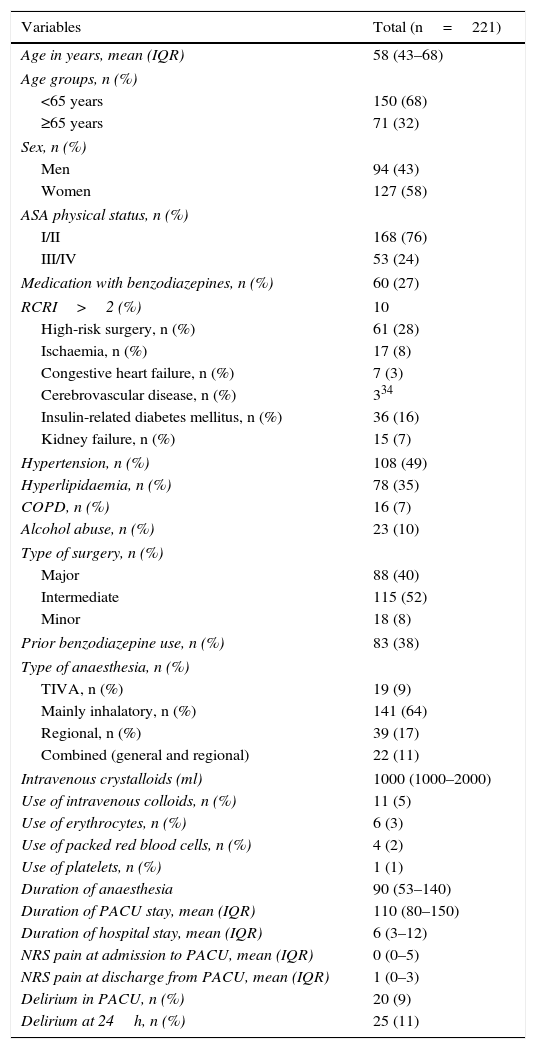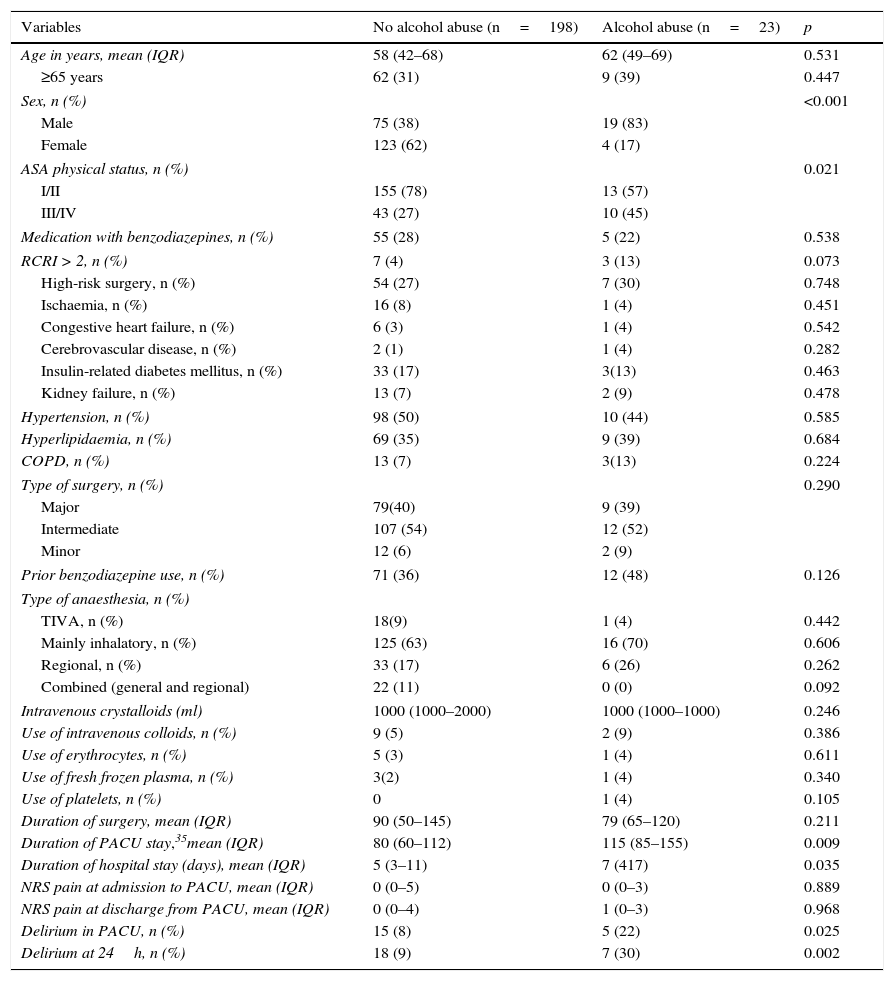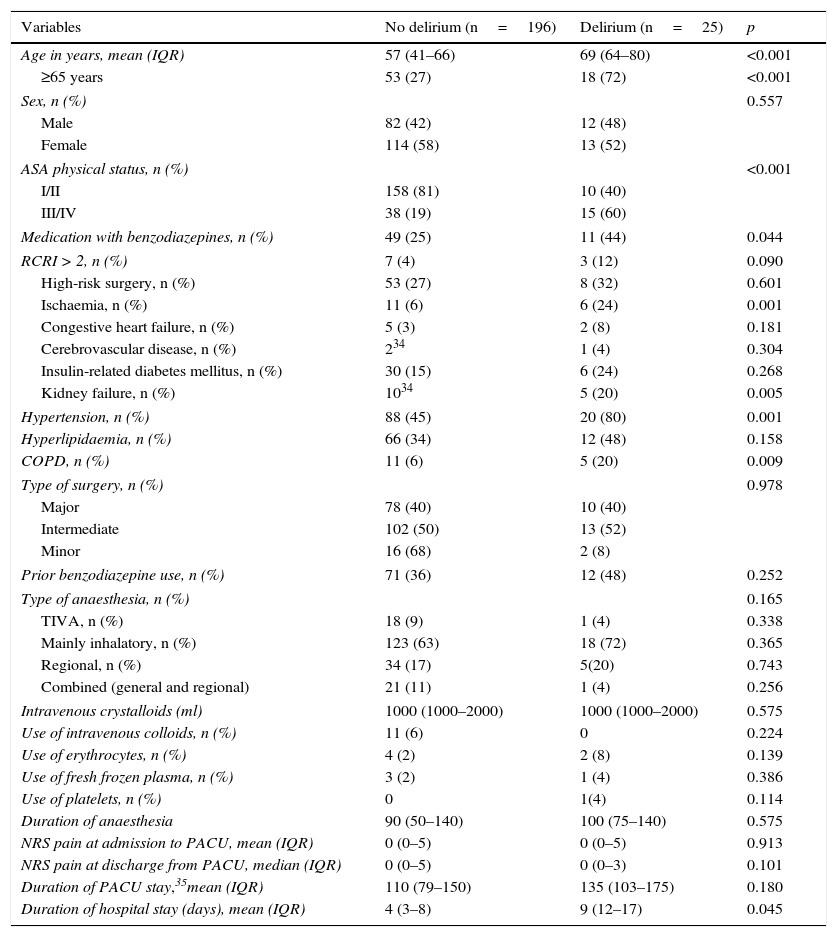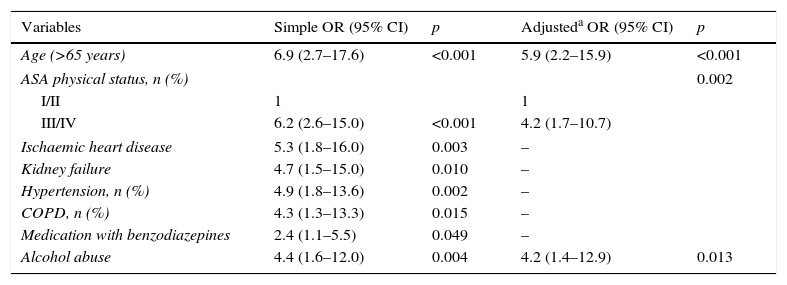Postoperative delirium (POD) is an acute confusional state characterized by changes in consciousness and cognition, which may be fluctuating, developing in a small period of time. The aim of this study was to evaluate the relationship between alcohol abuse and the development of POD.
MethodsWe prospectively evaluated consecutively all postoperative patients admitted in the Post-anaesthesia Care Unit over a 1-month period for delirium, using the Portuguese versions of the Nursing Delirium Screening Scale. Before surgery, alcohol consumption was inquired and alcohol abuse was assessed by the CAGE (Cutting Down, Annoyance, Guilt and Eye-opener) questionnaire; a score ≥2 defined alcohol abuse. Fischer exact test or chi-square was applied for comparisons. Risk factors were analyzed in a multivariate analysis using a logistic regression with odds ratios (OR) and 95% confidence intervals (95% CI).
ResultsTwo hundred twenty-one patients were enrolled. Delirium was seen in 11% patients. The incidence of alcohol abuse was 10%. Patients with alcohol abuse were more frequently men (p<0.001) and had a higher ASA physical status III/IV (p=0.021). POD was more frequent in patients with alcohol abuse (30% vs. 9%; p=0.002). Age (OR: 5.9; 95% CI: 2.2–15.9; p<0.001 for patients ≥65 years), ASA physical status III/IV (OR: 4.2; 95% CI: 1.7–10.7; p=0.002) and alcohol abuse (OR: 4.2; 95% CI: 1.4–12.9; p=0.013) were found to be independent predictors for POD.
ConclusionsOlder patients, higher ASA physical status and alcohol abuse were more frequent in patients with POD. Alcohol abuse was considered an independent risk factor for POD.
El delirio postoperatorio (DPO) es un estado confusional agudo caracterizado por cambios fluctuantes en el nivel de consciencia y la función cognitiva, que se desarrolla en un corto período de tiempo. El objetivo de este estudio fue evaluar la relación entre el abuso de alcohol y el desarrollo de DPO.
MétodosEstudio prospectivo incluyendo pacientes programados para cirugía electiva, admitidos en la unidad de cuidados post-anestésicos. Previamente a la cirugía, se preguntó a los pacientes sobre el consumo de alcohol, el cual se evaluó mediante el cuestionario Cutting Down, Annoyance, Guilt and Eye-opener (CAGE); la puntuación ≥2 se definió como abuso de alcohol. Las comparaciones se realizaron utilizando las pruebas exacta de Fischer o de χ2. Los factores de riesgo se analizaron mediante una regresión logística multivariante con razón de momios (RM) e intervalos de confianza del 95% (IC 95%).
ResultadosDoscientos veintiún pacientes fueron estudiados. El delirio se observó en el 11% de los pacientes. La incidencia del abuso de alcohol fue del 10%. Los pacientes con abuso de alcohol eran más frecuentemente varones (p<0,001) y tenían un mayor grado de riesgo perioperatorio de la ASA (ASA III/IV) (p=0,021). La edad (RM: 5,9; IC 95%: 2,2-15,9; p<0,001 para pacientes mayores de 65 años), el estado físico ASA III/IV (RM: 4,2; IC 95%: 1,7-10,7; p=0,002) y el abuso de alcohol (RM: 4,2; IC 95%: 1,4-12,9; p=0,013) resultaron ser factores predictivos independientes del DPO.
ConclusionesLas características más frecuentes en los pacientes con DPO fueron la edad avanzada, una mayor puntuación para el estado físico según la clasificación ASA y el abuso de alcohol. El abuso de alcohol se considera un factor de riesgo independiente para el DPO.










